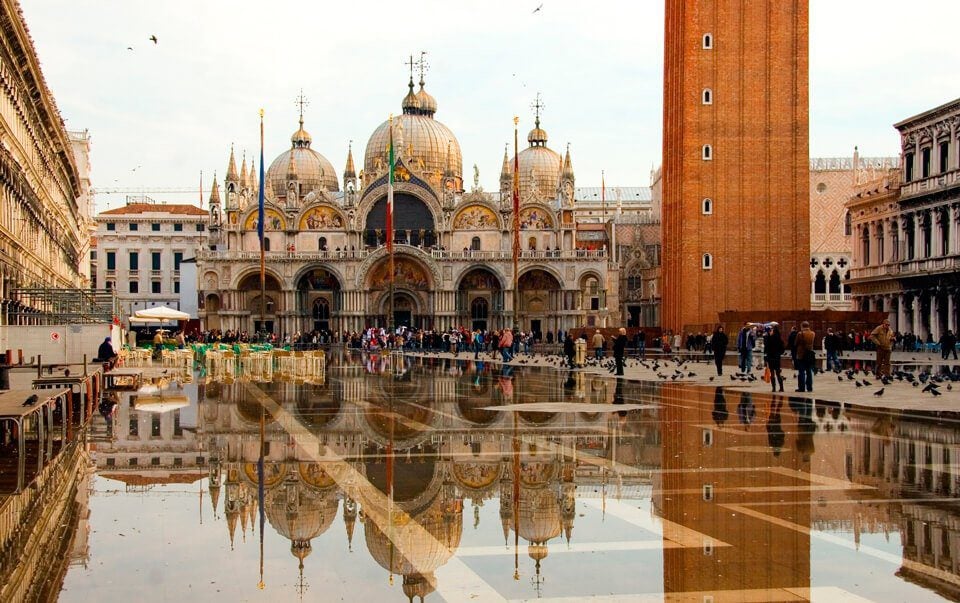St. Mark’s Square in Venice can be divided into two parts: the Piazzetta and the Piazza. The Piazzetta is a small area between St. Mark’s Square and the Giudecca Canal. It welcomes guests with entrance gates in the form of two granite columns. To the right of them stands the Doge’s Palace (the rulers’ residence), and to the left is the Marciana Library, ending with the Campanile. The central attraction is St. Mark’s Basilica — the main landmark of the city. Other interesting buildings include the Procuratie, the Clock Tower, and the Loggetta. It acquired its modern appearance, shape, and size by 1777. It is now 175 meters long and 82 meters wide.
San Marco – The Main Square of Venice
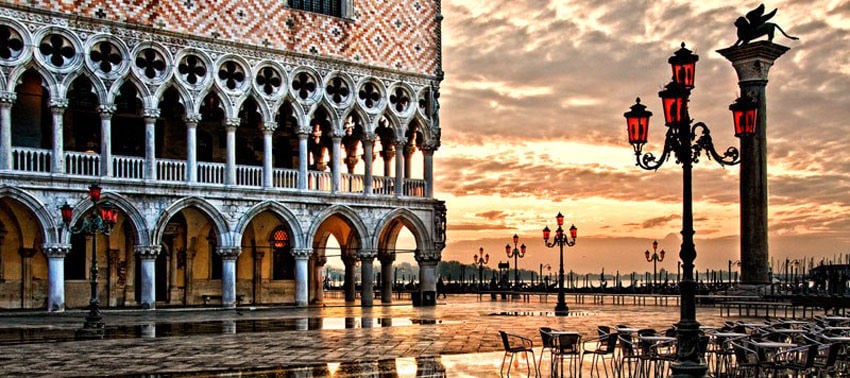
San Marco is the heart and calling card of Venice. While the city has many other squares, this is the only one called a piazza, highlighting its significance. The others are called campo, meaning “small field.” Piazza San Marco is a renowned historical and cultural center of Venice. For centuries, it has attracted millions of people worldwide, hosting city ceremonies, celebrations, and the famous Venetian Carnival.
History
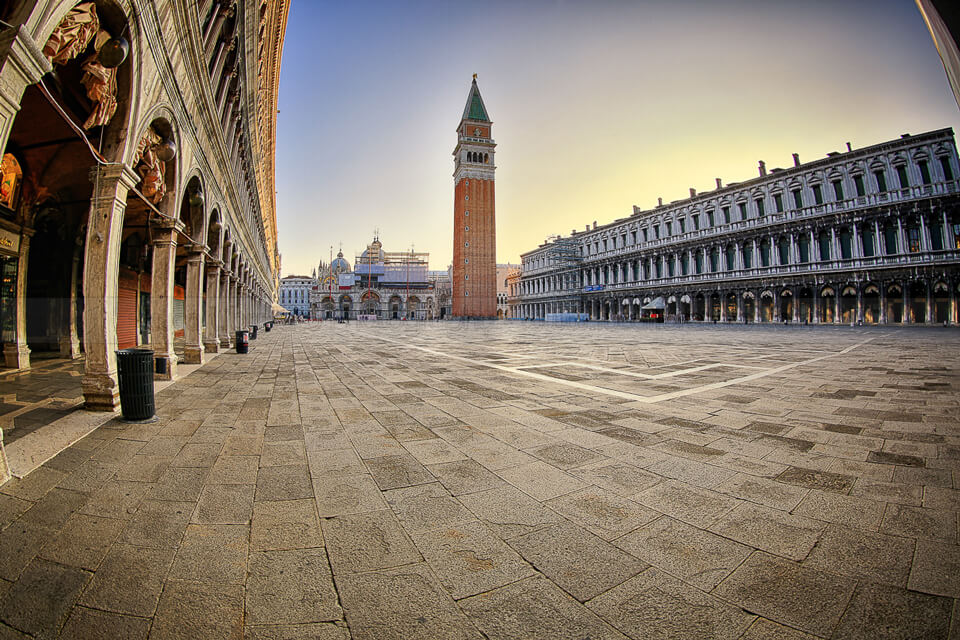
The history of this extraordinary place dates back to 829. Venetian merchants conducting trade in Egyptian Alexandria managed to secretly transport the relics of the great Christian saint, the Apostle Mark, hiding them in a sarcophagus among pig hides. Apparently, they noticed that Muslims never touched “unclean” cargo. The plan succeeded; customs inspection bypassed them, and the relics safely arrived in Venice.
The Basilica of St. Mark was built to house them, and the square in front of it was named accordingly. In 976, a fire severely damaged the building. A majestic cathedral was built in its place. The square gradually expanded, becoming the city center where all political events, public celebrations, and even executions took place.
Architectural Landmarks
Tourists begin to explore the landmarks as soon as they step out of the vaporetto (water taxis). Piazza San Marco is home to several historical buildings and structures.
Columns of St. Mark and St. Theodore
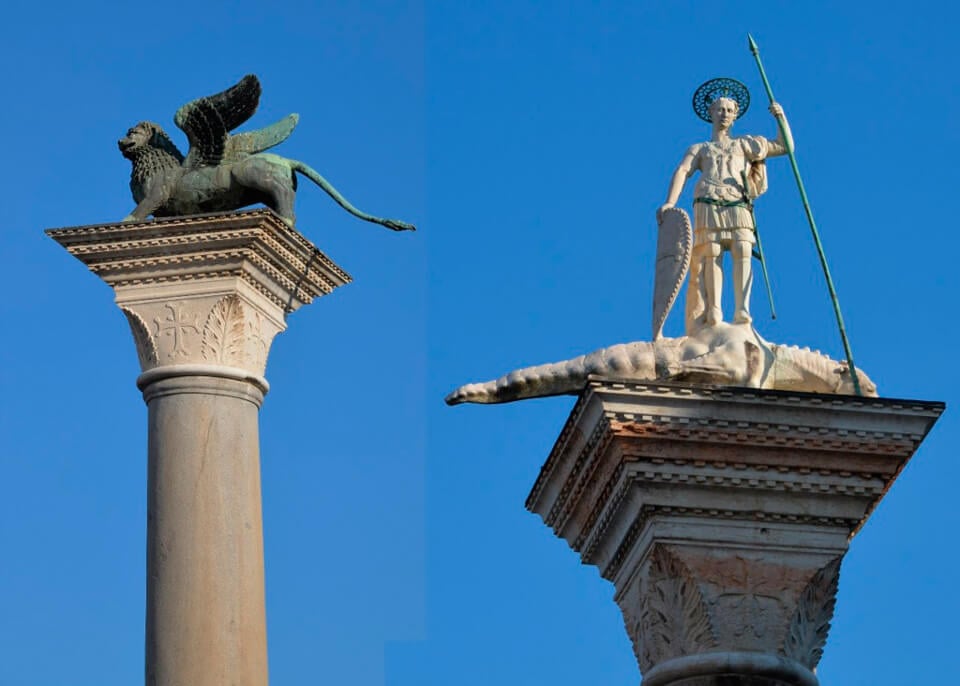
The first thing visitors see when stepping onto the Piazzetta pavement are two granite columns. They were brought from Constantinople in 1125 and installed only in 1196. The columns are monolithic and very heavy, each weighing over 100 tons, making them difficult to erect. One column is topped with a marble statue of St. Theodore with a spear, standing over a dragon. This scene symbolizes Venice’s power over the sea. St. Theodore was the city’s first patron saint and is still beloved and revered by Venetians.
The capital of the other column features a bronze winged lion with its paw on an open Gospel. The lion is a biblical symbol of St. Mark, depicted on Venice’s coat of arms. This figure is over 2500 years old. According to one version, it was brought from China; others see it as an example of Assyrian art. In the past, the space between the columns was used for executions. Venetians still consider it bad luck to walk there, where death sentences were carried out.
St. Mark’s Basilica
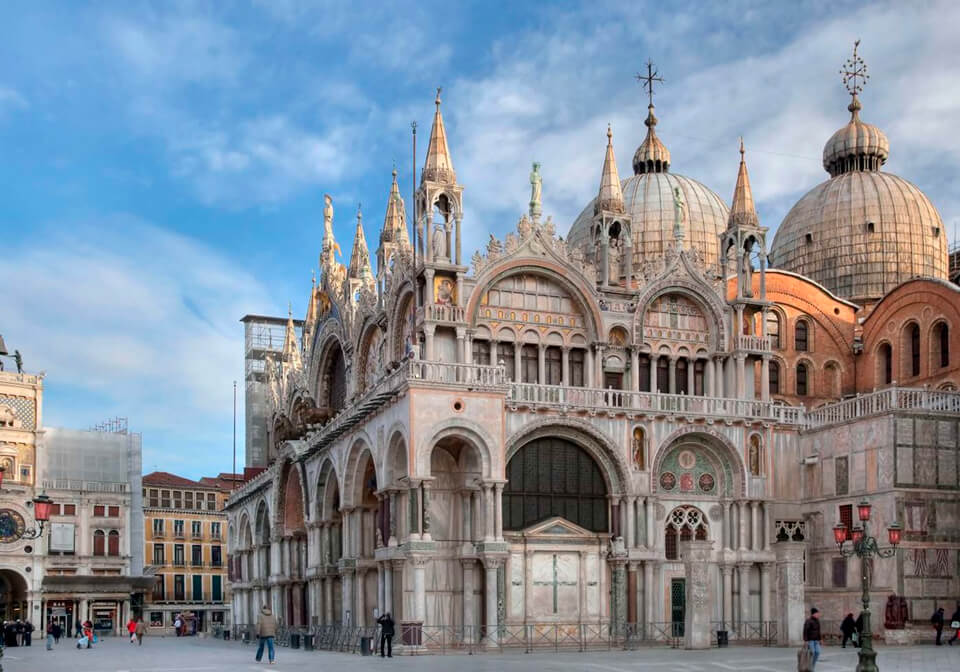
According to legend, the Evangelist Mark preached Christianity in the Venetian lagoon. One day, caught in a terrible storm, he waited it out and had a vision of an angel announcing he would find eternal peace on this land. For twelve centuries, St. Mark’s relics have rested under the basilica’s arches named in his honor. From the first glance, St. Mark’s Basilica amazes with its splendor. The basilica, built in 829, was severely damaged by the 976 fire, so a new building was constructed. The basilica took its current form in 1094.
During that period, Constantinople greatly influenced Venice. Consequently, the building was erected in a Byzantine pompous style, with a luxury uncharacteristic of Western European religious buildings. The marble facade is adorned with numerous columns, towers, bas-reliefs, and sculptures. The mosaic compositions depicting scenes of the “Last Judgment” and the “Theft of St. Mark’s Relics” are extraordinarily beautiful.
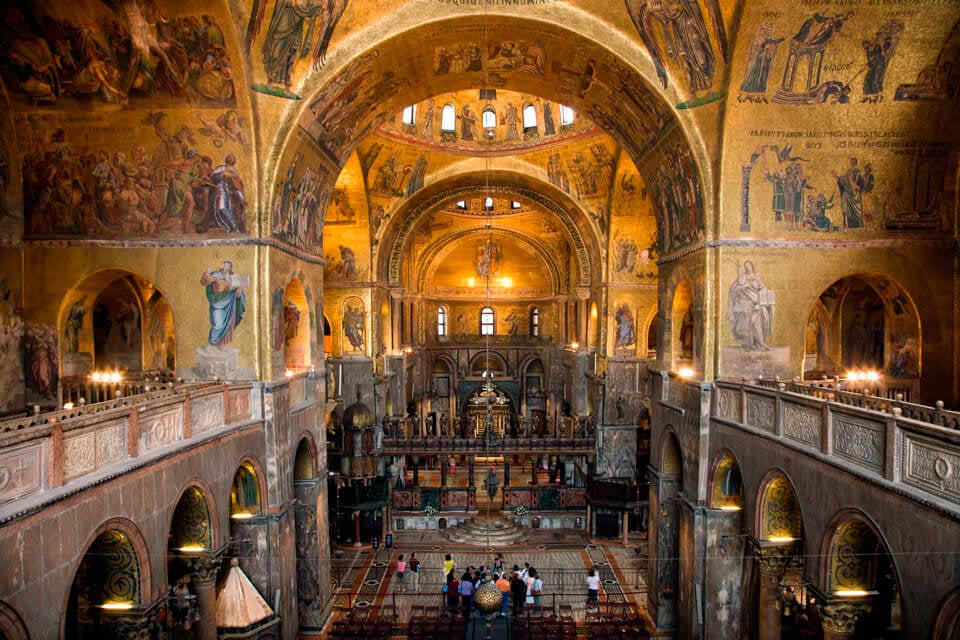
The basilica has five entrance portals. Above the main entrance is a majestic bronze quadriga (four horses). The sculptures are attributed to an ancient Greek master of the 4th century BC. They adorned Nero’s triumphal arch in Rome and later Trajan’s arch. The Venetians acquired them as a war trophy. The basilica is crowned with five domes, covered with silver rectangular plates.
The interior decoration is equally mesmerizing. Due to the abundance of gold, St. Mark’s Basilica is often called the “Golden Church.” The vaults, walls, and domes are adorned with mosaics made of colorful Murano glass. The dome is painted with scenes of the “Creation of the World.” However, the main treasure lies under the altar: the relics of St. Mark.
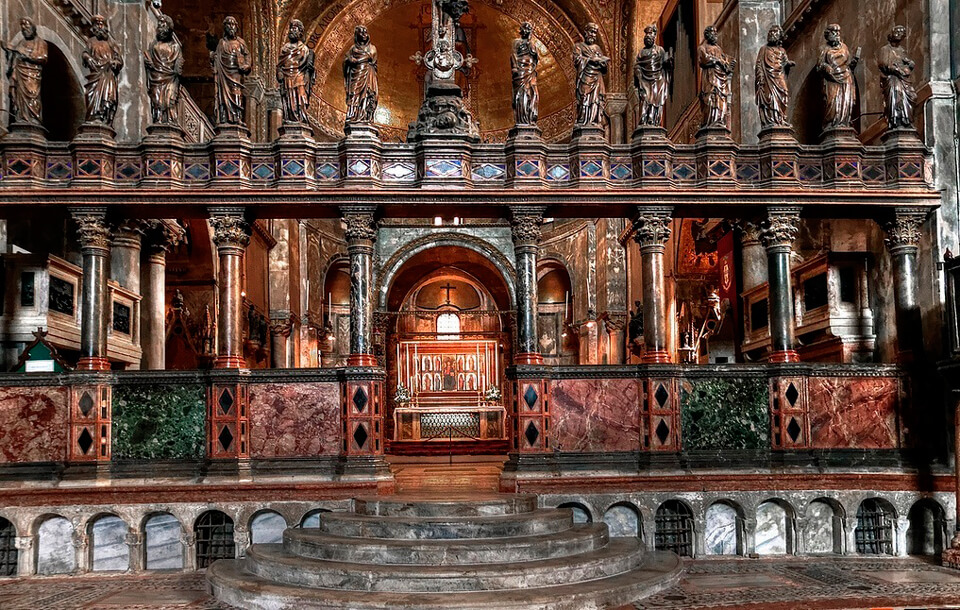
The Golden Altar is a magnificent Gothic masterpiece created in 1345. It measures 3.50 by 1.4 meters. It depicts episodes from the Scriptures and the life of St. Mark. The precious frame is inlaid with enamels and 2500 stones: amethysts, emeralds, sapphires, and rubies. The iconostasis is made of silver, covered with gold, and adorned with numerous enamel plates and precious stones.
Clock Tower
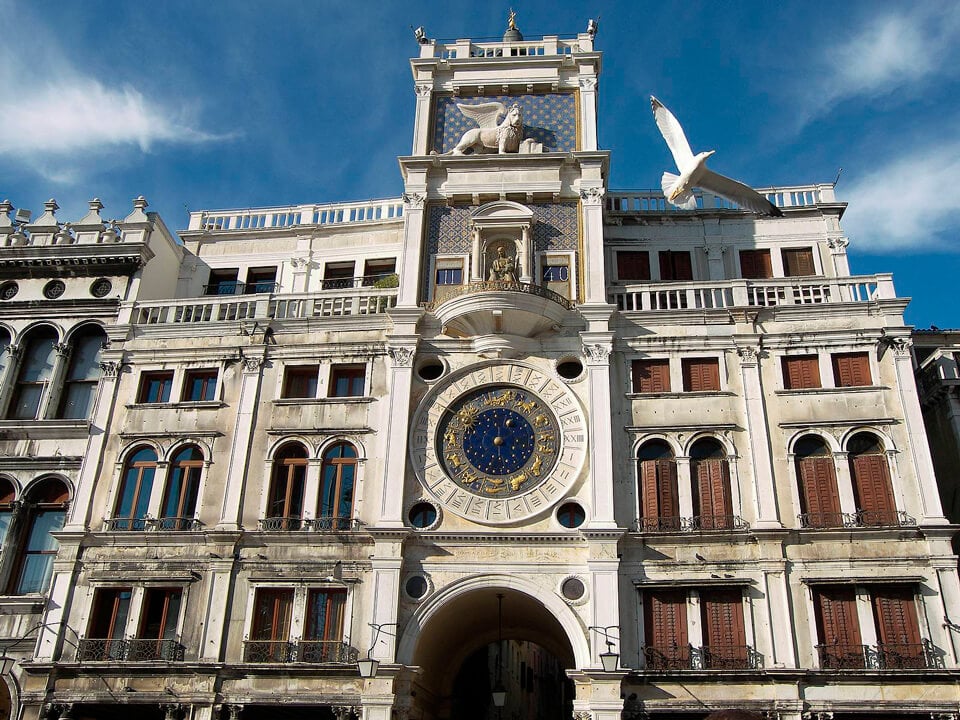
The building, constructed in 1499 under the direction of architect Codussi, consists of four parts. The main element is the blue and gold astronomical clock. The dial features two circles: the outer and the inner. The golden hand shows the time on the outer circle. The inner circle displays zodiac signs and moon phases. Above the clock is a copper statue of a seated Madonna with the infant Christ. Twice a year, on Epiphany and Ascension, the Magi appear before her, bowing.
On either side of the statue are small rectangular windows showing the current hours and minutes. Above is a sculpture of the winged lion holding an open Gospel. The tower is crowned with statues of two bronze Moors: an old man and a young man. They strike the bell with long hammers: five minutes before the hour and five minutes after. This symbolizes the passage of time.
St. Mark’s Library
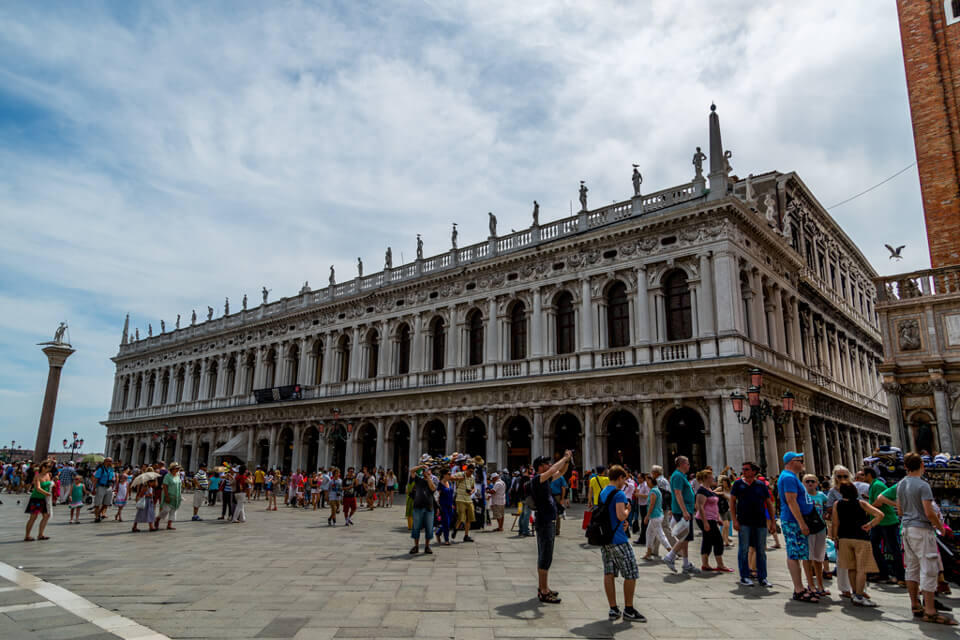
Located on the northern side of the Piazzetta, the library building is 80 meters long. It was constructed between 1537 and 1545 based on a design by architect Sansovino. Initially, the library was intended to house ancient Greek and Latin books and manuscripts donated to the city by Cardinal Bressanone.
In subsequent years, it was supplemented with war trophies, monastic, and family collections. Today, St. Mark’s Library (Marciana) holds about 40,000 unique items. The white marble facade is very elegant, adorned with statues, columns, and a balustrade. The interior decoration is equally refined: the walls are decorated with portraits of famous thinkers and philosophers, and manuscripts are stored in the gilded hall in exquisite bindings.
Doge’s Palace
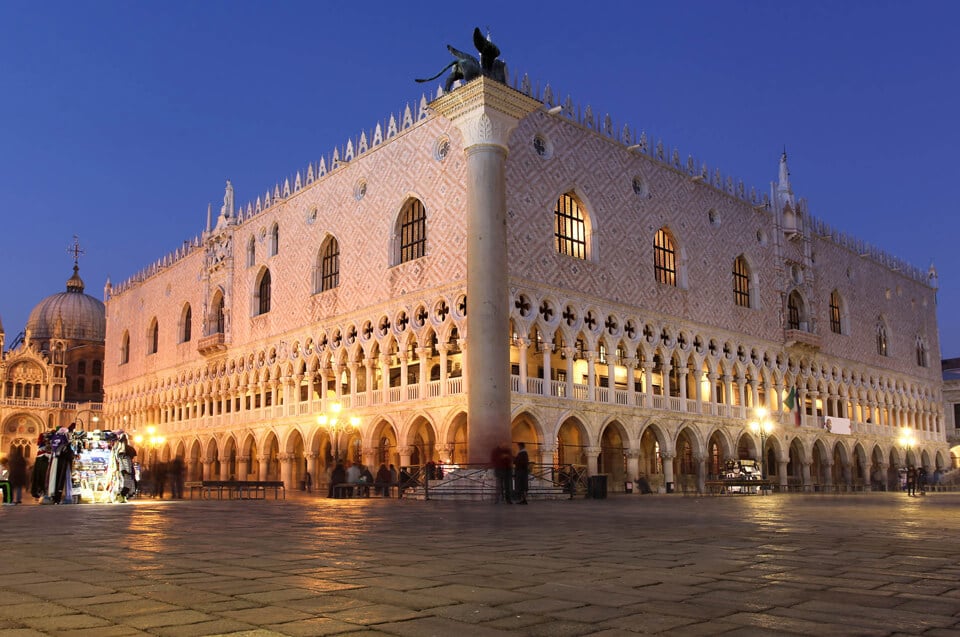
The Doge’s Palace, in Venetian Gothic style, is decorated with columns and lace arches, creating an impression of airiness and lightness. It faces the sea on one side and the square on the other. The Giants’ Staircase leads into the palace, flanked by two colossal statues symbolizing war and the sea: Mars and Neptune. Between them at the top is a bas-relief of the winged lion. Here, the elected Doges took their oaths.
Built in the 14th century, the Doge’s Palace had several functions:
- Private apartments of the Doge (ruler of Venice), where they lived and ruled
- Magistrature, where the Senate and various Collegia met
- Civil and ecclesiastical courts
- Tribune — the Doge addressed the people of Venice from the second-floor balcony
- Prison
In the magistrature halls, laws were discussed, political and ecclesiastical issues were resolved, and ambassadors and diplomatic missions were received. The Senate hall hosted trials, and the 18th-century judicial tribune has been preserved to this day. The palace’s interior is luxurious, with marble walls and ceilings, tapestries, and gold-trimmed leather.
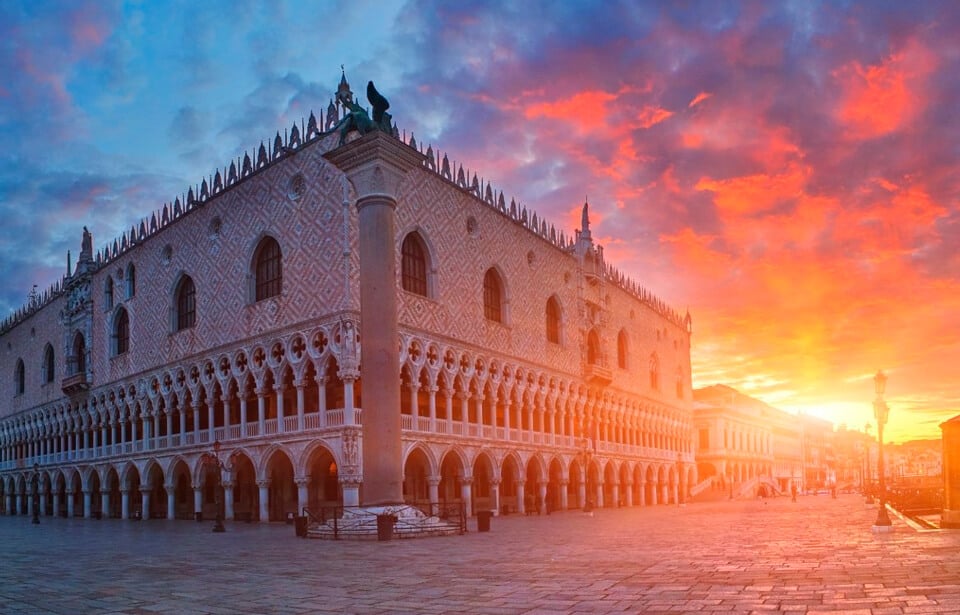
The decorations include paintings by genius artists such as Titian, Tintoretto, Pordenone, and frescoes by Paolo Veronese. Some depict scenes glorifying Venice: victorious battles, fleet construction, sea battles. Others show episodes from the Scriptures and ancient gods. The unique collection of weapons, including combat, decorative, and trophy items, is noteworthy. The exhibition comprises 2031 items, including the armor of French King Henry IV, crusader knights, a Turkish standard, sabers, and muskets.
Old and New Procuratie

The Procuratie were built to accommodate the highest officials of the executive power — the Procurators. Their duties included implementing the decrees of the Doge and the Senate in finance, law, property, politics, and other areas. The first Procuratie — the Old Procuratie — was built on the northern side of the square in 1532. It is a long three-story building with arches, loggias, and columns. Due to the expanding bureaucratic apparatus, one building was insufficient.
In 1586, the New Procuratie was built opposite the Old Procuratie. In 1810, by Napoleon’s decree, another building — the Ala Napoleonica (Napoleon’s Wing) — was constructed on the western side of the square, connecting both Procuratie. All buildings were constructed in a unified Renaissance style. The upper floors now house museums, and the lower floors are occupied by cafes.
Sansovino’s Loggetta
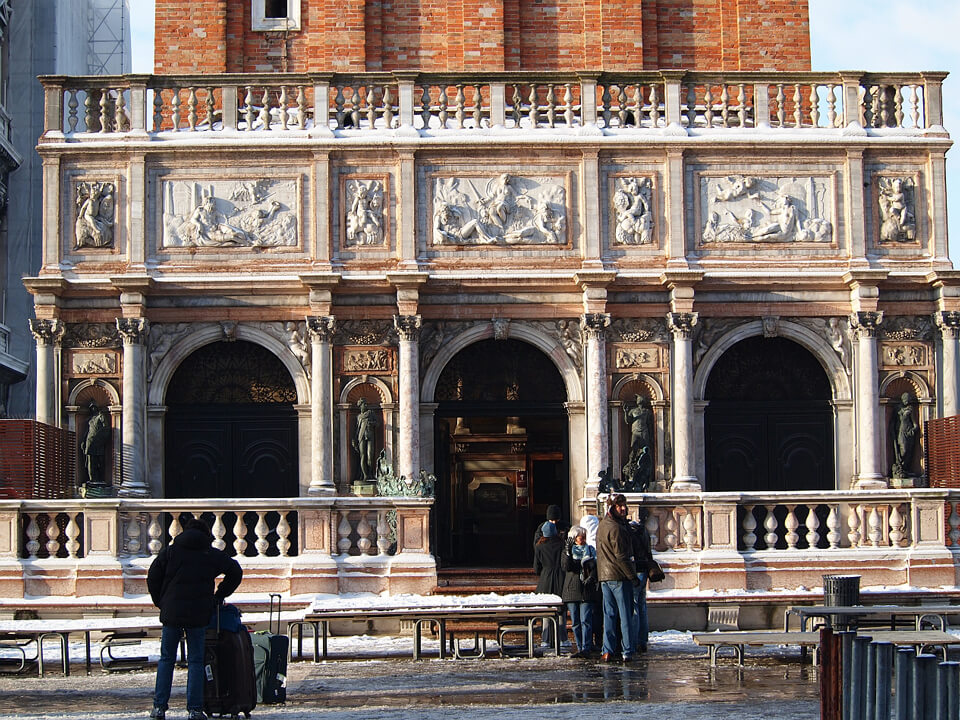
The Loggetta is a small exquisite building designed by architect Sansovino in the Baroque style, adjoining the Campanile. It was built between 1537 and 1540. The facade is made of white and colored marble, adorned with columns, bas-reliefs depicting scenes from ancient mythology, and statues of gods. For a long time, the Loggetta served as a meeting place for noble patricians. Later, it housed the guards of the Doge’s Palace. Today, the Loggetta serves as the entrance to the Campanile’s observation deck.
Campanile
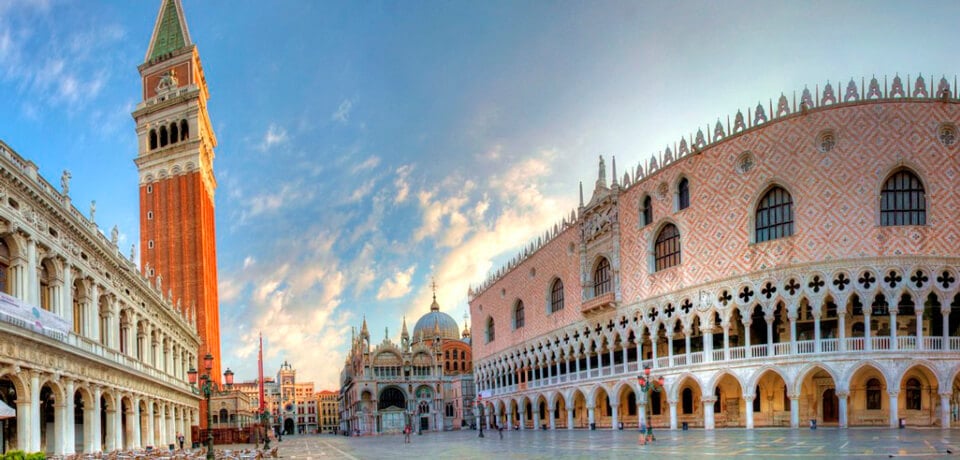
The Campanile is the observation deck and bell tower of St. Mark’s Basilica. It has a square base with a side length of 12 meters and a height of 98.6 meters. It is built of brick, topped with a marble bell chamber with five bells, and decorated with statues of the goddesses Justice, Venus, Minerva, and a winged lion. The bell tower is topped with a spire in the shape of a pyramid, with a 2-meter-tall golden archangel weather vane at the top.
The first tower on this site was built in the 9th century and served as an observation deck and lighthouse. In the early 16th century, a new bell tower was constructed, which stood for almost 400 years until it collapsed in 1902. Restoration took ten years, and the original appearance was fully restored.
San Marco – The Square of Pigeons
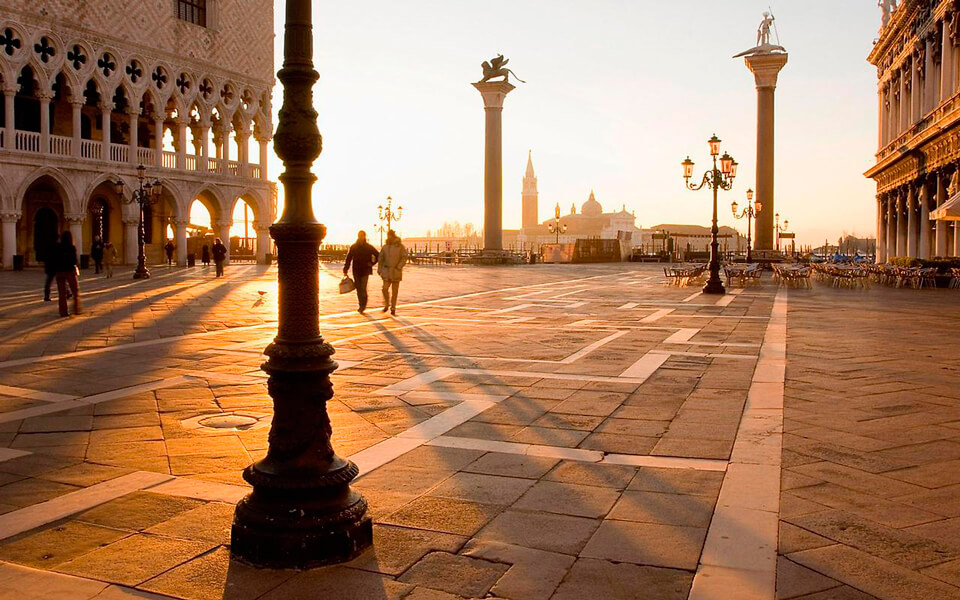
Pigeons have become an integral part of Piazza San Marco. According to legend, many guests attended the basilica’s consecration, bringing gifts, including two pigeons released into the square. They perched on the basilica’s cornice, symbolizing a sacred sign, and pigeons were deemed sacred. Since then, there has been a tradition of protecting and feeding the birds.
Over time, the pigeon population grew significantly. For sanitary reasons and to limit reproduction, the pigeons are fed special feed. Until 2008, bags of grain could be purchased in the square, but then sales were banned, and tourists were prohibited from feeding the birds.
Hours of Operation and Ticket Prices
The operating hours of the attractions on Piazza San Marco vary by season. The high season is considered to be April to October, and the low season is October to April.
St. Mark’s Basilica:
- Entry to the basilica is free. Weekday hours: 9:30 AM – 5:00 PM; weekends: 2:00 PM – 5:00 PM.
- Tickets to the St. Mark’s Museum cost 5 €. Open daily: 9:45 AM – 4:50 PM.
- Entry to the Treasury costs 3 €. Weekdays: 9:45 AM – 5:00 PM; weekends: 2:00 PM – 5:00 PM.
- Entry to the Golden Altar costs 2 €. Weekdays: 9:45 AM – 5:00 PM; weekends: 2:00 PM – 5:00 PM.
During the low season, visiting hours are reduced by one hour. Entry to the basilica with luggage is prohibited, and photography, videography, loud talking, and open clothing are not allowed.
Doge’s Palace:
- High season hours: 8:30 AM – 7:00 PM. Low season hours: 8:30 AM – 5:30 PM.
- Ticket price: 19 €; 12 € for children aged 6-14 and people over 65. The ticket also grants access to the Correr Museum, the Archaeological Museum, and the library.
St. Mark’s Campanile:
- October, Easter – June: 9:00 AM – 7:00 PM; November – Easter: 9:30 AM – 3:45 PM; July – September: 9:00 AM – 9:00 PM.
- Ticket price: 8 €.
Location and How to Get There
San Marco is the center of Venice. Since the entire city is on islands, public transport consists of vaporetti (water buses). These small boats travel between the islands along the Grand Canal on established routes. Venice is connected to mainland Italy by a causeway. Trains arrive at the Santa Lucia railway station, and buses stop at the station near Piazzale Roma. From there, you can walk to the center or take a vaporetto (fare 7 €) No. 1, No. 2, No. 4.1, No. 5.1, or N (night route) to the “Piazza San Marco” stop.
From the airport, located 12 km from the city, buses run from 5:20 AM to 12:20 AM, with a ticket price of 8 €. They stop at Piazzale Roma.

